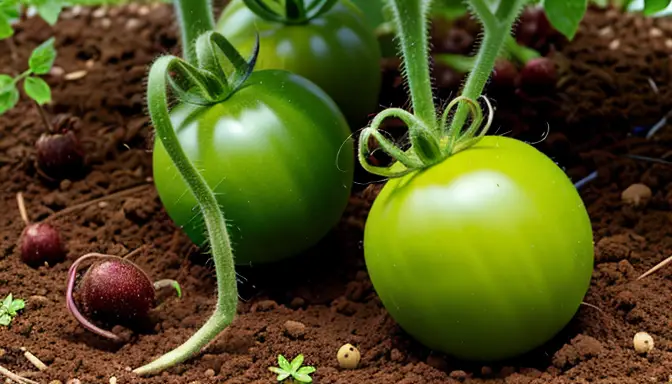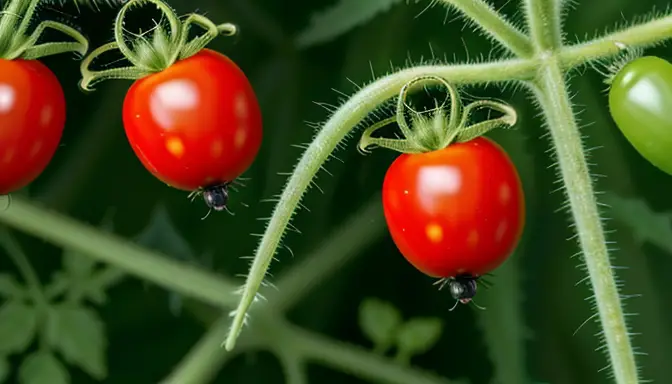Integrated pest management is like having a secret recipe for a pest-free garden paradise .
Embrace this holistic approach to gardening, and watch your tomato plants thrive under the watchful eye of beneficial insects .By blending together the powers of nature, science, and a sprinkle of magic, you can create a harmonious ecosystem where pests are unwelcome guests..
Ah, the sneaky intruders of the tomato world ! These tiny troublemakers can wreak havoc on your precious plants if left unchecked. Keep a keen eye out for aphids, hornworms, and those elusive spider mites ️. Knowing your enemy is the first step towards victory in the battle of the bugs.
Say goodbye to chemical warfare and hello to the wonders of organic pest control ! Nature provides us with powerful allies like neem oil and diatomaceous earth to combat pesky invaders. Your tomatoes will rejoice in the natural defenses you provide, and you’ll feel like a gardening superhero in the process.
Who needs a security system when you have plant besties watching your back? Pair your tomato plants with basil and marigolds, forming a formidable alliance against unwanted pests . It’s like creating a botanical Avengers team, but with more flowers and fewer capes.
Get your mixing bowl ready and whip up some homemade pest control sprays to show those bugs who’s boss ! Combine garlic, chili peppers, and a dash of soap to create a spicy concoction that will send pests packing ️. Your garden will thank you for the flavorful protection.
Not all bugs are created equal, some are the unsung heroes of your garden ! Ladybugs and lacewings are the true MVPs, keeping the pest population in check without asking for much in return. Treat them with respect by avoiding harsh pesticides and letting them thrive alongside your tomatoes.
Just like a
wardrobe change with the seasons, your pest control strategies need to adapt to the ever-evolving bug trends .It’s a garden fashion show where the bugs are the models, and you’re the savvy designer.Stay one step ahead by adjusting your methods to match the seasonal bug runway..
A healthy tomato plant is like a fortress against pests . Regularly inspect your plants for any signs of distress or disease, addressing issues promptly to prevent bug invasions. Think of it as giving your tomatoes a spa day, pampering them to ward off any unwanted guests.
The Importance of Integrated Pest Management
Integrated pest management (IPM) is the unsung hero of sustainable gardening practices .
This holistic approach not only safeguards your precious tomato plants but also nurtures a thriving ecosystem in your backyard.By harmonizing a symphony of biological, cultural, and chemical control methods, gardeners can orchestrate a pest-free paradise without disrupting the delicate balance of nature ..
Imagine a g
arden where ladybugs dance merrily among the leaves, where earthworms perform an underground ballet, and where every bug has its role to play in the grand scheme of things. That’s the magic of IPM – it’s like conducting a botanical orchestra where every instrument plays in perfect harmony . So, next time you spot a pesky intruder on your tomato plants, remember the mantra of IPM and embrace the power of unity in pest control!Identifying Common Tomato Pests
Integrated pest management is crucial for sustainable gardening . By combining biological, cultural, and chemical control methods, you can effectively manage pests without harming beneficial insects . Remember, a healthy garden is a happy garden!
Tomato plants often fall victim to sneaky intruders . Knowing your enemy is half the battle; keep an eye out for aphids, hornworms, and spider mites ️. These tiny troublemakers can wreak havoc on your precious tomatoes, so be vigilant in your pest patrol.
Chemical pe
sticides are so last season! Embrace organic remedies like neem oil and diatomaceous earth to fend off pests naturally . Your tomatoes will thank you for the chemical-free care they receive, and your garden will thrive in harmony with nature.Who knew plants could be besties too? Pair your tomato plants with basil and marigolds for a natural bug-repelling squad . It’s like having tiny plant bodyguards standing watch over your precious tomatoes, keeping the pests at bay.
Get crafty in the garden with homemade pest control sprays . Mix up concoctions using garlic, chili peppers, and soap to give those pesky bugs a spicy surprise ️. Your homemade spray will not only deter pests but also add a touch of DIY flair to your gardening routine.
Not all bug
s are bad! Ladybugs and lacewings are your garden’s unsung heroes . Avoid broad-spectrum pesticides to keep these good bugs around, as they play a crucial role in maintaining a balanced ecosystem in your garden.As the seasons change, so do the pests .
It’s like a fashion show for bugs! Stay on-trend with your pest control techniques to ensure your tomatoes remain pest-free throughout the year.Stay ahead of the game by adjusting your pest control methods to match the seasonal bug trends..
Healthy plants are less appetizing to pests . Regularly inspect your tomato plants for signs of distress and disease, and address issues promptly to prevent bug invasions. Remember, a little plant TLC goes a long way in keeping your garden thriving and bug-free.
Organic Solutions for Bug Infestations
When it comes to battling those pesky pests on your precious tomato plants, it’s time to ditch the chemical warfare and opt for nature’s own remedies. Chemical pesticides are so last season! Embrace the power of organic solutions like neem oil and diatomaceous earth to create a bug-free sanctuary for your tomatoes .
Neem oil, extracted from the seeds of the neem tree, acts as a natural insect repellent, disrupting the pests’ hormonal balance and leaving them confused and deterred. On the other hand, diatomaceous earth, a powdery substance made from fossilized algae, may look harmless but is a formidable foe against crawling insects. Its abrasive texture shreds the exoskeletons of bugs, causing them to dehydrate and meet their demise. Your tomatoes will thank you for choosing these gentle yet effective solutions!
Remember, a
healthy garden is a happy garden, and organic pest control methods not only protect your plants but also safeguard the environment and beneficial insects buzzing around. So, bid farewell to harsh chemicals and welcome the wonders of nature into your tomato patch .Companion Planting for Pest Prevention
Pairing up your beloved tomato plants with the right companions can create a harmonious garden ecosystem .
It’s like having tiny plant bodyguards! These aromatic allies not only keep pests at bay but also enhance the flavors of your tomatoes. Imagine your garden as a bustling community where each plant plays a vital role in protecting and nurturing its neighbors.Who knew plants could be besties too? Pair your tomato plants with basil and marigolds for a natural bug-repelling squad ..
In the world of gardening, it’s all about strategic alliances. By companion planting, you’re essentially creating a plant posse that watches out for each other. Basil’s strong scent confuses pests, while marigolds release compounds that repel nematodes. Together, they form a formidable defense against unwanted insect invaders. So, next time you’re tending to your tomato patch, remember to invite these green guardians to the party . Your tomatoes will thank you, and your garden will flourish in harmony!


